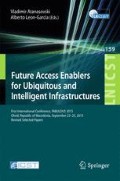Abstract
Human presence in the vicinity of a wireless link causes variations in the link’s Received Signal Strength (RSS). Device-free Localization (DfL) systems use these RSS variations in a static Wireless Sensor Network (WSN) to detect and locate people in the area of the network. The main advantage of this emerging technique is localization of people without requiring them to carry any devices. This paper investigates the feasibility of a DfL system using a Sun SPOT WSN. The system uses 16 Sun SPOT sensors and covers 4 × 4 m square area, which is a size of a typical living room. The sensors exchange testing messages, measure RSSs and forward the results to a host computer via a base station. The host application processes the received RSS values using the Radio Tomographic Imaging (RTI) technique and displays a real-time image with the estimated position of the person in the monitored area.
Access this chapter
Tax calculation will be finalised at checkout
Purchases are for personal use only
References
Moeslund, T.B., Granum, E.: A survey of computer vision-based human motion capture. Comput. Vis. Image Underst. 81(3), 231–268 (2001)
Bulling, A., Blanke, U., Schiele, B.: A tutorial on human activity recognition using body-worn inertial sensors. ACM Computing Surveys 46(3), Article No. 33 (2014)
Herrera, J., et al.: Evaluation of traffic data obtained via GPS-enabled mobile phones: The Mobile Century field experiment. Transp. Res. Part C: Emerg. Technol. 18(4), 568–583 (2010)
Winkler, T., Rinner, B.: Security and privacy protection in visual sensor networks: a survey. ACM Computing Surveys 47(1), Article No. 2 (2014)
Wilson, J., Patwari, N.: Radio tomographic imaging with wireless networks. IEEE Trans. Mob. Comput. 9(5), 621–632 (2010)
Adler, S., Schmitt, S., Kyas, M.: Device-free indoor localisation using radio tomography imaging in 800/900 MHz band. In: International Conference on Indoor Positioning and Indoor Navigation, Busan (2014)
Bocca, M., Kaltiokallio, O., Patwari, N.: Radio tomographic imaging for ambient assisted living. In: Chessa, S., Knauth, S. (eds.) EvAAL 2012. CCIS, vol. 362, pp. 108–130. Springer, Heidelberg (2013)
Kaltiokallio, O., Bocca, M., Patwari, N.: A multi-scale spatial model for RSS-based device-free localization. IEEE Transactions on Mobile Computing, arXiv:1302.5914 [cs.NI] (2013)
Wilson, J., Patwari, N.: See through walls: motion tracking using variance-based radio tomography networks. IEEE Trans. Mob. Comput. 10(5), 612–621 (2011)
Zhao, Y., Patwari, N.: Histogram distance-based radio tomographic localization. In: 11th ACM/IEEE International Conference on Information Processing in Sensor Networks (IPSN), pp. 129–130 (2012)
Bal, G.: Introduction to inverse problems. In: Lecture Notes - Department of Applied Physics and Applied Mathematics, Columbia University, New York (2012)
Kabanikhin, S.I.: Definitions and examples of inverse and ill-posed problems. J. Inverse Ill-posed Problems 16, 317–357 (2008)
Acknowledgments
This work is supported by the EC FP7 eWall project (http://ewallproject.eu/) under grant agreement No. 610658. The authors would like to thank everyone involved.
Author information
Authors and Affiliations
Corresponding author
Editor information
Editors and Affiliations
Rights and permissions
Copyright information
© 2015 Institute for Computer Sciences, Social Informatics and Telecommunications Engineering
About this paper
Cite this paper
Chomu, K., Atanasovski, V., Gavrilovska, L. (2015). Device-Free Localization Using Sun SPOT WSNs. In: Atanasovski, V., Leon-Garcia, A. (eds) Future Access Enablers for Ubiquitous and Intelligent Infrastructures. FABULOUS 2015. Lecture Notes of the Institute for Computer Sciences, Social Informatics and Telecommunications Engineering, vol 159. Springer, Cham. https://doi.org/10.1007/978-3-319-27072-2_12
Download citation
DOI: https://doi.org/10.1007/978-3-319-27072-2_12
Published:
Publisher Name: Springer, Cham
Print ISBN: 978-3-319-27071-5
Online ISBN: 978-3-319-27072-2
eBook Packages: Computer ScienceComputer Science (R0)

